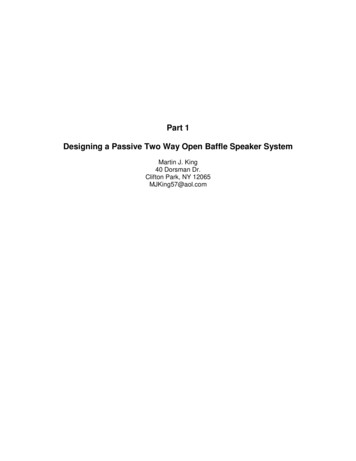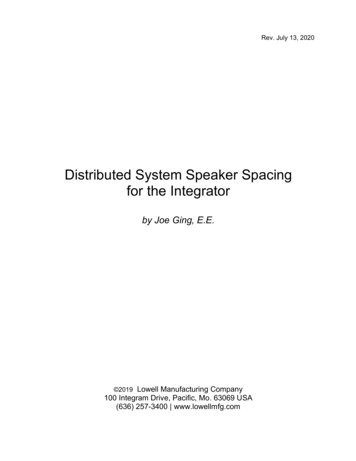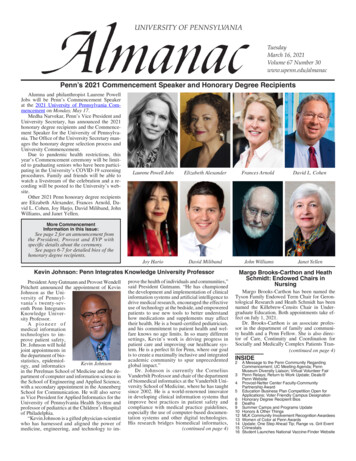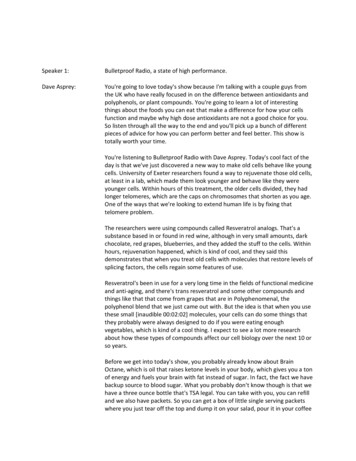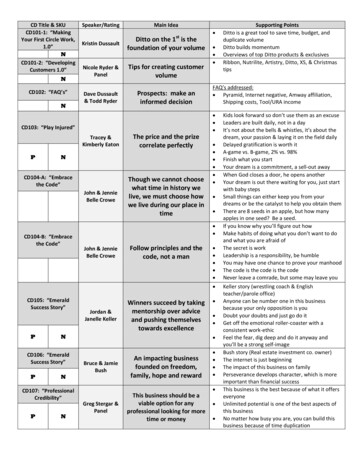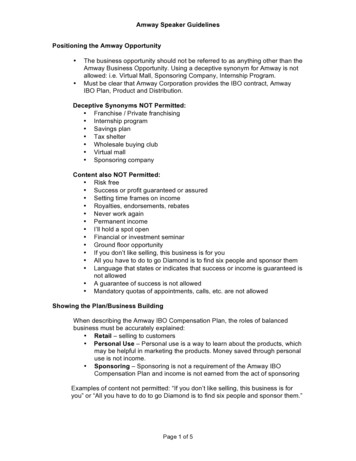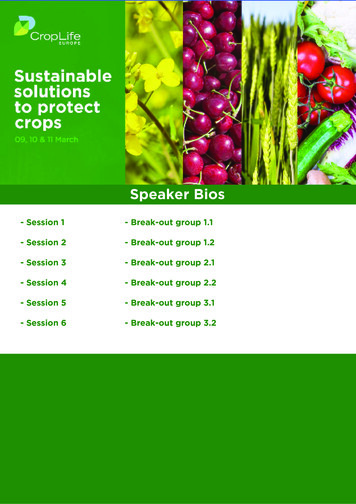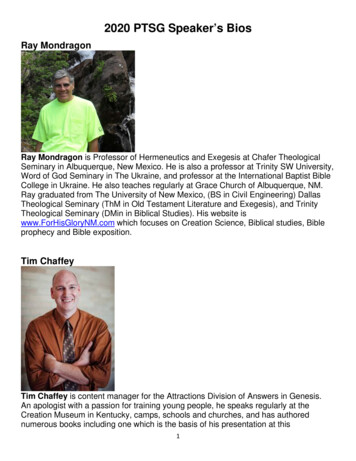
Transcription
-REAL ENGLISH SPEAKER5 Steps To EnglishFluencyLearn how to become a more confident, fluent EnglishSpeaker.My 5 fun, practical steps to English Fluency .made with
-Table Of ContentsThis is your personal English Fluency Pocket Book.You can refer to this book whenever you want for your Englishpractice.Use the steps in this book to help you feel more confident with yourEnglish speaking.What's inside this book?1. What is Fluency?2. Step 1 - Reading Aloud3. Step 2 - Listening Exercises4. Step 3 - Practice Thinking In English5. Step 4 - Talking To Yourself6. Step 5 - Write in A Journal7. How To Start A Conversation.8. Resource List
-What is Fluency?How can you become a more fluent English speaker?We talk about a lot about ‘fluency’ in English. But whatexactly is fluency?How can you become a more fluent English speaker?We talk about a lot about ‘fluency’ in English. But what exactly isfluency?Fluency is defined as;“the ability to speak or write a particular foreign languageeasily and accurately.“And what does this involve? What do we need to be fluent?To be completely fluent we need confidence to use the language in thesekey areas;SPEAKINGLISTENINGREADINGWRITINGThere are so many methods and ideas and suggestions out there! It canfeel overwhelming.Overwhelming is an adjective which means too much or toobig. We can say “excessive”. When something isoverwhelming it can be difficult to absorb all the information.
But I’m going to ‘narrow it down’ for you (to ‘narrow something down’ isa phrasal verb which means to ‘simplify’ or make something easier tounderstand or learn.Follow these steps every week and you will make BIG improvements inyour English!
-Step 1 - Reading AloudRead aloud in English for 15 minutes a dayWhat does ‘read aloud’ mean? This means reading from your book andspeaking the words out at the same time. This will help your Englishimprove in a big way! Reading aloud from a book will help improve yourpronunciation, your understanding of grammar and sentence structure, itwill build your vocabulary and most importantly, it will give youCONFIDENCE with your speaking.Important points: To get the best results from this exercise, you shouldfollow these steps;Start very slowly.When you read and speak aloud, do it slowly. Think about what you aresaying and how you should form the sounds and say the words. (later youcan get faster!)
Use the BIG MOUTH technique.What is this? This is my special technique for improving yourpronunciation. While you are speaking out the text, open your mouth verywide with each word. Really exaggerate the sounds.to ‘exaggerate’ something means to represent (something) asbeing larger, better, or worse than it really is.So when speaking the text, do it more. Do it big! Imagine there is aninvisible tennis ball in the middle of your mouth, sitting on your tongue.You have to ‘talk around’ this ball. This might seem like a strange exercise,but I promise you if you do this you will notice that your pronunciation isalmost instantly clearer! Why? Because you are forcing your mouth to workharder to make the new sounds and you are thinking carefully about whatyou are saying.Don’t worry. You don’t have to talk like this forever! This exercise is only tohelp you adapt to the different sounds of English, which you don’t use inyour own native language.After some time, you can start to read and speak faster and in a morenormal way.
Try this with my original mini story HEREHOT TIP – For best results, do this before you go to sleep at night. You mayDREAM in English! This is a good sign for your -------------------------------------FREE AUDIOBOOKBy Nick DaleLearn common phrasal verbs and expressions on the topic of travel.Listen to real, native Australian English speakers talking at an airport. Thenlearn the common phrases and how to use them.Listen to and read an original mini story to understand the phrases incontext.
-Step 2 - Listening ExercisesListen to audio booksListening is the best way to become a fluent English speaker. Why? Becauselistening is the most natural way that we learn a language. As children, thisis how we learnt our native language – by listening to the adults around us,our parents, teachers, grandparents and so on. We listened and copied thesounds and started to make sentences.Since this is natural to us, why not use it when learning English?Listening to audio books is not only an effective way to ‘pick up’ (acquire /gain / learn) the language but it’s also convenient because you can do itanywhere (listening on your headphones while travelling and walking etc).It’s also interesting and educational.My tips for listening to audio books.1. Start with short stories (you don’t want to get overwhelmed!)2. Find the transcript or text and read as you listen.3. Then listen again while you are doing an activity (such as cleaning,walking, working out at the gym)4. SHADOWING – Listen again and pause the audio. Repeat thesentences. Try to ‘mimic’ – copy – the speech patterns as accurately aspossible. You might need to do this a few times. This is great for yourpronunciation.Some resources for audio books;For lower levels – Try THIS SITE– A free audio book site for Englishlearners.For higher levels – Try AUDIBLE– You can find many audio books, bothnew and classic, on this site. You can also get a one month free trial.
Here are two original mini stories I wrote, with audio, for you topractice your English listening and to learn new phrases and vocabularyin context.Click on the images to hear the audio. Below are the links for the text.THE ROAD TRIP TEXTJENNY'S WILD TRIP TEXT
-Step 3 - Thinking InEnglishLearn how to think in English to boost your fluencyHow do we do this?Take 30 minutes (or an hour) of your day to name everything you see inEnglish. So when you are walking around, sitting at your office desk, doingyour work etc, look around you. What do you see? Think about exactly whatyou see, but don’t think of the objects in your native language. Think ONLYin English. Start simply by just thinking in words first. Then you can moveto sentences.For example – I am sitting in a cafe, doing work on my computer at themoment. What do I see?“A computer .A computer screen . A cafe . Chairs . Waiters Lots of books! .Sugar . Cups .and more!Then –Books .Interesting books . Those books look interesting. .Quiet. It’s very quiet. A quiet cafe .
Try to put words together in your mind. Then make sentences.I made a video about thinking in English too!. It’s called “3 WAYS TO THINKIN ENGLISH”www.realenglishspeaker.com
-Step 4 - Talk To YourselfTalking to yourself is a great way to improve your Englishfluency.This is strange, isn’t it? But actually, it’s healthy to talk to yourself. To speakyour thoughts out aloud. It helps you to get your thoughts clear and makedecisions. But try to do this in English!This is similar to the thinking in English activity but you are speakingyour thoughts. When you are at home (you might need to be alone!), try tospeak your thoughts out aloud. You can do this while you are doing somehouse chores (housework) such as cleaning or cooking.
For example;I’m very tired today . Today was such a busy day . I’m sohungry .What should I eat for dinner? Hmm maybe i’ll havepizza, or chicken. What should I do with chicken? Make achicken salad? A chicken curry? .I don’t know how to makechicken curry Where can I get a recipe? .This may be difficult at first, but don’t worry about speaking perfectEnglish. Just try! The more you do this, the better you will get.www.realenglishspeaker.com
-Step 5 - Write In A JournalUse 'stream of consciousness' writing to build your fluency.A journal is a private notebook where you can write all your thoughts,feelings and ideas.I suggest you do ‘stream of consciousness’ writing. What is this? Thismeans you simply write about anything that comes into your mind. So,again, this is similar to the thinking and speaking exercises, but you do thisin writing.Set your timer for 10 or 15 minutes. Put your pen to the paper and justwrite! Don’t stop! Even if you just write words, or parts of sentences. This isa time when you can forget about grammar and spelling. The purpose ofthis exercise is just to help you think more freely in English.So just keep writing and trying to put your thoughts and feelings down onthe paper.
So here you have 5 practical ways you can build and expand your Englishfluency. With these exercises you are using all 4 key skills; speaking,listening, reading and writing. You are bringing English into your life!Soon you will start to feel more confident and you will be surprised howquickly your English will improve.Written By Nick DaleYour English Fluency Coachwww.realenglishspeaker.com
-How To Start AConversationSound like a native speaker with these common conversationstarters.In this chapter I will give you some common, informal greetings that youcan use in everyday conversation. I'm going to give you a variety of optionsyou can use. (It is great to have a variety of greetings and conversationstarters so you can be more interesting!)Please note - The bolded words and phrases are the ones I consider the mostcommonly used.With friends;INFORMAL ways to say HELLO.START: HELLO; Hey / Hi / Howdy (US)/ Hey mate! (m/f) (mostly men)Hey bro /brother (m)/ Hey man!(m) (from US)/ Hey buddy (US)/ Hey sis!(sister) / Hey honey / Hey darls (short for darling)/ Hey huns (short forhoney) / Hey sweetheart/sweetie– (these more common for women –sometimes men) (Parents call their children ‘sweetheart’ and ‘sweetie’.Seniors (above 60) also call younger people this. )How are ya? (How are you?)/ How ya doing? (How are you doing?)(from US)/ How’s things? (friends) / How ya going? / How’s it going?RESPONSE 1; I’m good. You? / I’m going well. How about you? / I’m goodthanks! And yourself? / Great, thanks! How are you? / I’m ok / I’m alright /Not bad / I’m fine / Not so great.
Tip - Don’t use “I’m fine” too much. “I’m fine” may mean you want to closethe conversation / you don’t really want to talk much. I’m fine can alsomean “not so good”Try something more like this;I’m pretty good, thanks. How about you? / And you? / And yourself? (It isconsidered friendly to ask the person "How are you?" back. Or the shortform "And you?" "And yourself?" This is very much a part of Australianculture in particular)www.realenglishspeaker.com
MAKE MORE CONVERSATION:What’s up? (US) / What’s been happening? / What’s new? / How’s life?(personal)/ How’s it been going?Q: What’s been happening? What HAS been happening?A: I’ve been stuck in traffic. / I’ve been working hard. / I’ve been really busy.I HAVE BEEN VERB INGE.G - I have (I've) been cooking lately / recentlyAnother common question in conversation:*INFORMAL - This is a common question in Australian EnglishWhat did you get up to yesterday? (means What did you do yesterday?)What didya gettupto yesterday?Other questions;How’s work? / How’s your love life? (This is more personal. We would onlyask our close friends this)FURTHER RESPONSESforWhat have you been doing? / What have you been up to?Not much / The usual / Same old (this means nothing new or interestinghas been happening)Lots of stuff! (busy) / I’ve been really busy! / It’s been crazy (busy) lately /Just working / I’ve started a new job / I’ve met someone new(boyfriend/girlfriend)/ I’ve been dating / You won’t believe whathappened .(tell an interesting story)
**TIP** – "The usual" / "The same old" is a slightly boring response. If youwant to continue the conversation – you should talk about something youdid recently, or something interesting that happened.HOT TIP – talk about something you saw in the news (but try to keep itpositive). Or a film you have seen. Or something that happened just beforeyou met the person.For SENIOR (older) people – Hi / Hello / Good morning / Good afternoon /Good evening. How are you? How are you going?www.realenglishspeaker.com
HOMEWORK TASKPractice using a variety of greetings, questions and responses to keepyour conversations interesting. Start a conversation with someone in English today. It can be anyone;Someone waiting at the bus stopSomeone sitting next to you on the trainThe waiter at the local cafeAn English speaker at your universityIf you don't live in an English speaking country and you can't find someonewho speaks English;Join an English Conversation groupFind an English group on Facebook or Google Plus (there are manyEnglish practice communities there)Send an SMS (text) to someone you know who speaks English and askto practice in text messages.Find an English tutor in iTalki.comwww.realenglishspeaker.com
www.realenglishspeaker.com
-Resource ListNICK’S LIST OF GREAT RESOURCES FOR ENGLISH SUCCESS!READCheck out these great BLOGS for reading practice;NEWS ARTICLESInternational news - http://www.bbc.com/news/world/US news - http://edition.cnn.com/Australian news - http://www.news.com.au/Sydney Morning Herald - http://www.smh.com.au/Entertainment news - http://au.eonline.com/PERSONAL DEVELOPMENTTINY BUDDHA http://tinybuddha.com/BOUNCE http://thebounceblog.com/POSTIVELY POSITIVE (Great one!) fastcoexist.com/ .boredpanda.com/TRY THIS FICTION STORY: (for higher levels)JONATHAN LIVINGSTON SEAGULL(You can find a FREE PDF file on Google)
LISTENTED TALKSwww.ted.com(this one has many short speeches about technology, education and design.It is really interesting! Take a look!)INFINITE WATERShttps://www.youtube.com/user/Kemetprince1(If you’re interested in Personal .com/http://www.vocabulary.com/ENGLISH FLUENCY COACHINGWant to train your English fluency to thenext level?For more information on my English FluencyTraining programs, check out my website:www.realenglishspeaker.com
THE REAL ENGLISH FLUENCY PROGRAMWant to move your English to the next leveland finally feel confident to speak withnative speakers?Join my 10 module Real English FluencyProgram.An online program that you can takeanytime, anywhere.Click here for more details
MY ENGLISH FLUENCY NOTESUse this space to take any notes from the course.www.realenglishspeaker.commade with
This is your personal English Fluency Pocket Book. You can refer to this book whenever you want for your English practice. Use the steps in this book to help you feel more confident with your English speaking. What's inside this book? 1. What is Fluency? 2. Step 1 - Reading Aloud 3. Step 2 -



